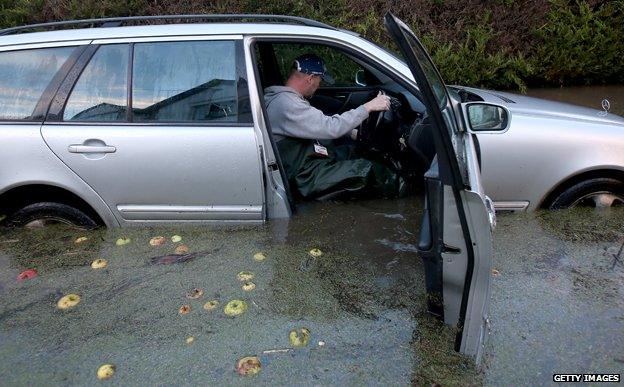Who, What, Why: How do you drive in floods?
- Published

Many of the UK's roads are very wet or submerged after weeks of rainfall. How do you drive in floods, asks Tom de Castella.
Drivers in Essex had to be rescued from their cars by fire fighters after not heeding flood warnings. Motorists are advised to plan their route carefully and avoid lowland areas near rivers, says Peter Rodger, chief examiner at the Institute for Advanced Motoring. But if you are confronted by flooding or large pools on the road, how should you react?
Slow down to give yourself time to assess how deep the water is and whether it is moving, Rodger says. A good rule of thumb is not to enter water more than six inches deep, or four inches if it is moving, he adds. For a vehicle with high clearance like a 4x4 this may be slightly higher. Risks include shorting the electrics, flooding the engine, underwater obstructions or being swept away. If you can't see where you are going to come out of the water, consider turning round. Enter the water slowly so that only your front wheels are submerged. If you feel the water is moving, reverse out before you become stuck. Drive on the shallowest section of the road. Leave space to avoid swamping others. Don't go too fast - it risks letting water into the engine. Keep the revs high to stop water entering the exhaust. Stay in first gear and drive at walking pace - about 2-3mph. Use the clutch to allow greater revving. On an automatic use the brakes to achieve the same effect. Never take your foot off the accelerator, Rodger warns. Once out of the water, lightly brake to dry the brakes. If you do get stuck, unless your life is in danger, ring for help before leaving the vehicle, Rodger says. Even this advice could be in vain, warned the Telegraph, external. "Giant 4x4s or trucks racing though in the opposite direction can create such bow waves they drown your car."
Aquaplaning occurs when there is water on the road surface, you are travelling fast, and the tyres lose their grip. It needn't be deep water. It feels like you're on black ice as you lose steering control, Rodger says. You should ease off on the power. But on no account turn the steering wheel. If you turn the wheel and the tyres suddenly grip again the car can go into a spin, Rodger says. There are two lessons drivers should heed if they aquaplane - you're going too fast and your tyres may be worn.
Follow @BBCNewsMagazine, external on Twitter and on Facebook, external